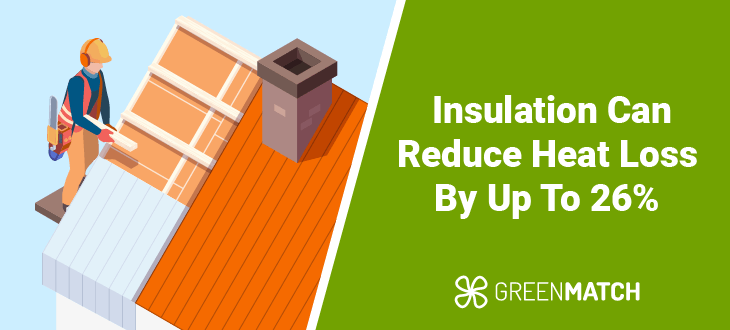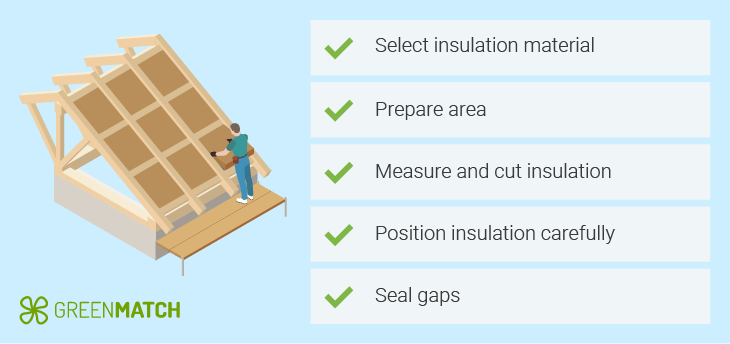Answer these simple questions and we will find you the BEST prices
Which type of solar quotes do you need?
It only takes 30 seconds
100% free with no obligation

Get Free quotes from insulation specialists near you

Save money by comparing quotes and choosing the most competitive offer

The service is 100% free and with no obligation
- GreenMatch
- Insulation
- Insulating Your House
- DIY Roof Insulation
DIY Roof Insulation: How to Do It & Is It a Good Choice?


- Roof insulation can drastically reduce heat loss by up to 26%, leading to significant savings on energy bills, carbon emission reductions, and a comfortable living environment.
- Many roof insulation methods, like roll or batt insulation, are easy to handle, making them suitable for DIY enthusiasts.
- DIY roof insulation can help you save on costly labor fees; however, for the best results, professional installation is recommended.
Roof insulation goes beyond just saving on energy costs; it is a significant investment in your home’s overall efficiency and sustainability. Proper insulation can enhance comfort, reduce environmental impact, reduce energy bills, and increase property value.
This guide aims to provide you with all the essential information you need about DIY roof insulation in the UK. You’ll find details on the various materials available, step-by-step installation tips to ensure a successful project and an overview of the numerous benefits associated with insulating your roof.
Ready to insulate your roof? Look only as far as GreenMatch UK for a comprehensive solution. Fill out our quick 30-second form to receive up to 3 free, home-tailored quotes from professional roof insulation installers. Click below to get started!
- Describe your needs
- Get free quotes
- Choose the best offer
It only takes 30 seconds



Is DIY roof insulation possible?
Yes, DIY roof insulation is a manageable home improvement that boosts energy efficiency and lowers energy bills. Doing it yourself lets you control the project and save on professional fees.
However, there are some potential drawbacks to keep in mind with DIY insulation:
- Workmanship challenges: Poor insulation installation can result in air leaks or uneven coverage, reducing effectiveness and potentially causing issues like mould or moisture buildup.
- Repair costs: Mistakes during installation can lead to costly repairs, often offsetting the savings intended from DIY.
- Time investment: While a professional can complete the insulation in a day, DIY installations can take significantly longer, especially for those unfamiliar with the process.
- Need to purchase tools: You’ll need to purchase specific tools for the job, which can add to your overall expenses. Items like insulation cutters, staple guns, protective gear, and measuring tools are essential for proper installation, and their costs can add up.
Which roof insulation methods can you DIY?
For roof insulation, some methods are well-suited to DIY enthusiasts, while others are better handled by professionals.
The ideal method depends on your roof type, skill level, and available tools. Below is an overview of methods and insulation materials you can tackle yourself and those best left to professional roof insulation installers.
Roll or batt insulation
Using roll or batt insulation is one of the simplest insulation methods for DIY enthusiasts. You can lay the insulation rolls or batts between the roof joists without technical difficulty, making it ideal for lofts and attics with accessible spaces.
- Materials: Commonly used materials include fibreglass, mineral wool, or sheep’s wool. These are accessible and easy to work with for most DIY projects.
- Safety considerations: When handling fibreglass, it’s important to wear protective gear like gloves, goggles, and a mask to avoid irritation and inhaling fibres.
- Cost-effective (fibreglass costs approximately £10 per m².
- High thermal resistance (R-values from 2.2 to 4.5).
- It is a simple way to minimise heat loss and improve comfort.
Loose-fill insulation
Loose-fill insulation can be an easy DIY option if you can access a blower. It’s particularly useful for filling gaps and covering hard-to-reach areas in the attic.
- Materials: This method typically uses cellulose or fibreglass, which is readily available for DIY.
- Safety considerations: To avoid inhaling particles, ensure the area is well-ventilated and wear appropriate protective equipment, such as a mask and goggles.
- Flexible for filling irregular or tight spaces.
- It is ideal for attics with difficult-to-access areas.
- It is an effective way to boost insulation without needing precision cutting.
Foam board insulation
These rigid boards can be cut to size and fitted between the rafters. While they may require tools like a utility knife or saw for cutting, they are manageable for DIYers who are comfortable handling essential tools.
- Materials: PIR (Polyisocyanurate) and PUR (Polyurethane) boards are commonly used for this method.
- Safety considerations: Ensure proper fitting and secure the boards correctly to avoid gaps that could reduce insulation efficiency. Wear gloves to protect your hands when cutting the boards.
- High thermal resistance (R-values up to 4.5) and low U-values (as low as 0.022 W/m²K).
- Affordable, with costs ranging between £5 and £15 per m².
- Suitable for improving insulation in various roof designs.
While some insulation can be DIY, spray foam insulation requires specialised equipment and expertise, as the rapidly expanding polyurethane foam must be applied precisely. Improper handling can lead to uneven application, poor coverage, or moisture issues that may damage roof structures, making it best left to certified professionals.
When correctly applied, spray foam insulation effectively seals gaps and prevents heat loss, with low U-values between 0.022 and 0.028 W/m²K, providing a durable, energy-efficient solution ideal for long-term insulation.
Ready to insulate your roof? GreenMatch UK has you covered! Simply fill out our quick 30-second form to receive up to three personalised quotes from professional roof insulation installers. Click below to get started!
- Describe your needs
- Get free quotes
- Choose the best offer
It only takes 30 seconds



How to install roof insulation DIY

Here is a step-by-step guide on how to install roof insulation as a DIY project.
- Choose the right insulation material: Select the best option for your roof and skill level. Roll or batt insulation (fibreglass, mineral wool) is easiest for DIY and fits between joists easily. Loose-fill (cellulose, fibreglass) works for hard-to-reach spaces but may need a blower. Foam boards (PIR, PUR) require cutting to fit rafters precisely.
- Prepare the space: Clear clutter from the loft, inspect for leaks or damage and fix any issues. Gather safety gear (gloves, goggles, mask) and tools like a utility knife and staple gun.
- Measure and cut the insulation: Measure the spaces between the joists, then cut the insulation slightly larger for a snug fit. Ensuring the roof insulation thickness is optimal will maximise efficiency and improve long-term energy savings.
- Install the insulation: Fit batt or roll insulation between joists without compressing. Use a blower to loose-fill gaps. Secure foam boards between rafters and seal joints with tape.
- Seal and finish: Seal gaps around vents and pipes with foam sealant. If necessary, install vapour barriers to prevent moisture.
While DIY roof insulation can be straightforward with the right materials and preparation, some situations require professional expertise:
- Complex roof designs: If your roof has a unique shape or limited accessibility, professionals can ensure insulation is applied correctly and efficiently.
- Specialised insulation types: Methods like spray foam require specialised equipment and precise application, making professional installation essential for safety and effectiveness.
- Long-term efficiency: Professionals have the experience to ensure that gaps or errors do not occur, maximising energy efficiency and avoiding costly mistakes.
By considering professional help, you can guarantee that your roof insulation is installed to the highest standard, ultimately saving on energy costs and improving home comfort for the long term.
Is it wise to insulate your roof yourself?
Taking on roof insulation as a DIY project can be a practical way to improve your home’s energy efficiency, but it’s important to consider the advantages and disadvantages before getting started. Here's a quick look at the key points.
- Cost savings: Installing roof insulation yourself can save you significant labour costs compared to hiring professionals. Choosing and installing the materials yourself keeps expenses lower.
- Control and flexibility: Doing the project yourself allows you to control the timeline and work at your own pace, choosing insulation types and methods that match your budget and abilities.
- Sense of achievement: Completing the installation yourself can be rewarding, as you know you have directly contributed to reducing energy loss and improving your home’s comfort.
- Precision and skill requirements: Some insulation methods, like foam board installation, require accurate measurements and fitting. Mistakes can lead to gaps, reducing the insulation’s effectiveness.
- Safety risks: Handling materials such as fibreglass can pose health risks if the right protective gear is not used. Working in confined roof spaces can also be hazardous without proper precautions.
- Complex methods unsuitable for DIY: Certain methods, such as spray foam insulation, are best left to professionals due to the need for specialised tools and expertise. Incorrect installation can result in moisture problems and damage to the roof structure.
- Additional costs: You will need to purchase tools and protective gear, increasing the overall cost.
While DIY roof insulation can work well for simpler methods like batt, roll insulation, or metal roof insulation, it may not be suitable for every homeowner. For more complex projects like dormer roof insulation, or if you're unsure about your skills, hiring professionals guarantees that the job is done correctly and safely. This approach helps avoid mistakes and extends the lifespan of your roof insulation.
Finding the right professional can be overwhelming, but GreenMatch UK makes it easy. Simply fill out our 30-second form to receive up to 3 free quotes from trusted local roof insulation experts. Our service is entirely free, so click below to get started today!
- Describe your needs
- Get free quotes
- Choose the best offer
It only takes 30 seconds



FAQ
You can insulate your roof using simple methods like roll, batt, or foam board insulation. However, following safety guidelines and ensuring proper installation is essential for effective results. Complex methods, like spray foam, are best left to professionals.
For DIY roof insulation, choose the right material (such as batt or roll insulation), prepare the area, and cut the insulation to fit between rafters. Install the pieces securely without compressing them, and seal any gaps with foam sealant or caulk to prevent heat loss.

Nicole Bea Kerr is a content writer for Greenmatch, leveraging her experience in B2B journalism and editing. She is interested in bringing more awareness to sustainability through informative narratives.
We strive to connect our customers with the right product and supplier. Would you like to be part of GreenMatch?

- Describe your needs
- Get free quotes
- Choose the best offer
It only takes 30 seconds



